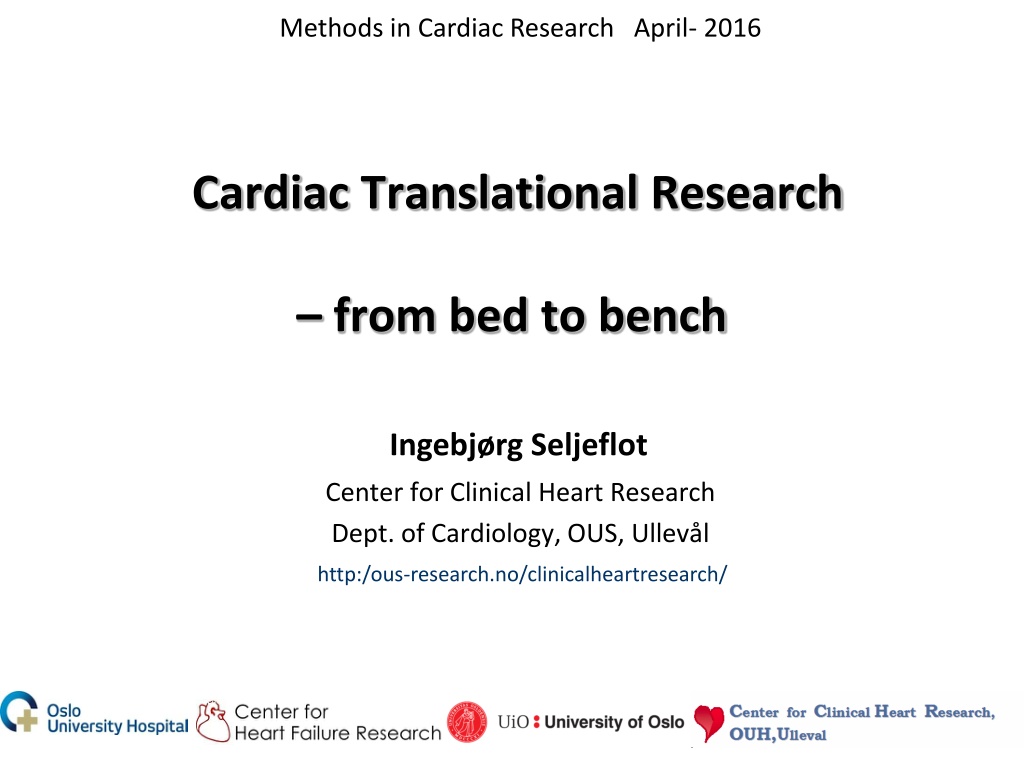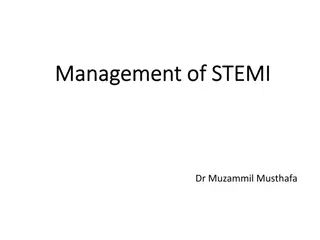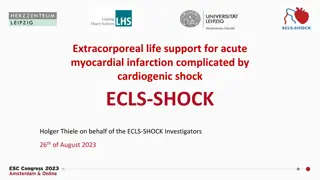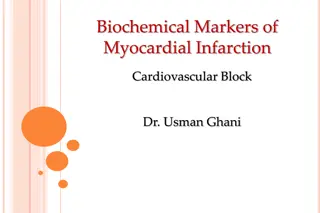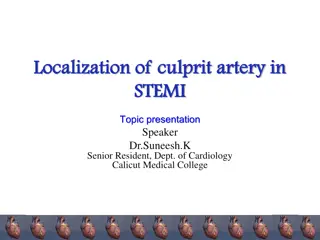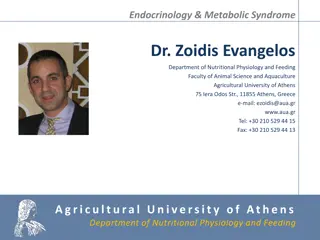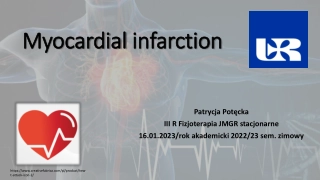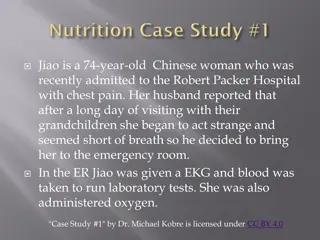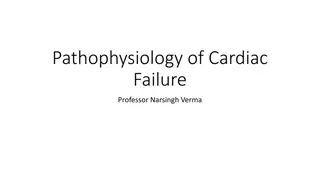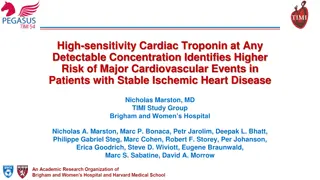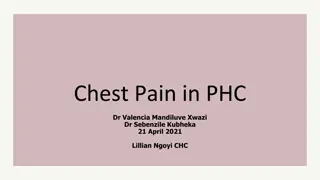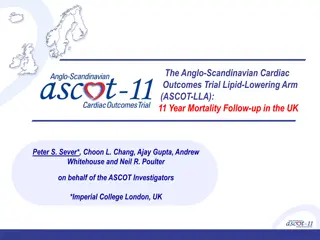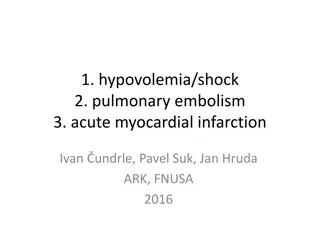Insights into Cardiac Research: Metabolic Syndrome and Acute Myocardial Infarction Studies
Explore the latest findings in cardiac research focusing on two critical clinical problems: Metabolic Syndrome (MetS) and Acute Myocardial Infarction. The studies involve human clinical data, blood sampling, adipose tissue biopsies, cell culture studies, thrombus aspiration, gene arrays, and regulatory mechanisms. Discover the prevalence of MetS in Norway and delve into the risk factors associated with cardiovascular diseases. Gain valuable insights from a clinical study on elderly men at high risk of CVD and their baseline investigation results related to inflammation markers and MetS components.
- Cardiac Research
- Metabolic Syndrome
- Acute Myocardial Infarction
- Cardiovascular Diseases
- Clinical Studies
Download Presentation

Please find below an Image/Link to download the presentation.
The content on the website is provided AS IS for your information and personal use only. It may not be sold, licensed, or shared on other websites without obtaining consent from the author. Download presentation by click this link. If you encounter any issues during the download, it is possible that the publisher has removed the file from their server.
E N D
Presentation Transcript
Methods in Cardiac Research April- 2016 Cardiac Translational Research from bed to bench Ingebj rg Seljeflot Center for Clinical Heart Research Dept. of Cardiology, OUS, Ullev l http:/ous-research.no/clinicalheartresearch/
Outline Clinical problem (1) Metabolic syndrome (MetS) / Type 2 diabetes Atherothrombotic / inflammatory disease Human clinical study / clinical data Blood sampling Adipose tissue / biopsies Cell culture studies Clinical problem (2) Acute myocardial infarction Human clinical study / clinical data Thrombus aspiration Blood sampling Gene arrays / Regulatory mechanisms Strategies and Prerequisites
MetS Prevalence in Norway the Norwegian HUNT 2 study. BMC Public Health 2007; 7:220 Figure 1. Age-specific prevalence of the metabolic syndrome in Norway. Adapted from Hildrum B (17). syndrome really exists (24). Furthermore, different combinations of these components might identify very different phenotypes, although the diagnostic criteria of the syndrome are fulfilled (9). 11
Clinical problem (1) The Metabolic Syndrome Abdominal obesity Elevated glucose Elevated Triglycerides Inflammation Thrombosis Hypertension Low HDL
Development of atherosclerosis/thrombosis Libby P. Circulation 2001; 104: 365
Clinical study Eldely men at high risk of CVD (n=563); The DOIT*- study *Randomized intervention study on the effects of diet and/or n-3 PUFA - 3 yrs follow-up for Cardiovascular Events Focus on MetS based on Biobanking Baseline investigation of markers of inflammation related to outcome Abdominal Obesity (>102 cm) Elevated Triglycerides (> 1.7 mmol/L) Elevated Glucose (> 5.6 mmol/L) MetS: Minst 3 av 5 komponenter Hypertension (> 130/85) Low HDL (< 1.0 mmol/L) ATP-III, Circulation 2005
Blood samples Baseline inflammatory markers vs CV-events after 3 yrs Events + (68) Events (495) p CRP (mg/L) 4.90 (3.36, 6.76) 3.12 (1.72, 5.85) <0.001 IL-18 (pg/mL) 334 (228, 421) 270 (216, 347) 0.007 IL-6 (pg/mL) 1.82 (1.14, 2.83) 1.48 (1.00, 2.44) 0.007 MCP-1 (pg/mL) 425 (378, 503) 429 (361, 516) n.s. TNF- (pg/mL) 1.07 (0.76, 2.26) 1.12 (0.79, 1.90) n.s. Adiponectin (ng/mL) 8467 (5271, 12490) 13.3 (9.1, 22.5) 8143 (5210, 13485) n.s. PAI-1 activity (U/mL) 13.7 (8.3, 21.5) n.s.
IL-18 Mets + (n=29/139) and Mets (n=39/424) CV-events in Q of IL-18-levels in Mets + Mets - p=0.008 for trend Tr seid M, Seljeflot I, Hjerkinn EM, Arnesen H. Diabetes Care 2009; 32: 486-492
Significant interaction between IL-18 and Glucose CV-events i Q of IL-18 in patients with High (>6.2mmol/L) vs Low Glucose Number of CVD- events by quartiles of IL-18 in subjects with (black bars, n=139) and without (white bars, n=424) elevated fasting glucose. Glucose > 6.2 mmol/L Glucose < 6.2 mmol/L ns p=0.001 (trend) Tr seid M et al. Diabetes Care 2009
IL-18 Tr seid et.al 2009
Adipose tissue IL-18 gene-expression in individuals + / - MetS from the same population IL-18 Subcutanous adipose tissue MetS: n=22 No MetS: n=36 IL-18, IL-6 and PAI-1 Gene-expression related to the different components in MetS
Relative mRNA expression in adipose tissue mRNA expression in adipose tissue in subjects with and without MetS Associations between IL-18 mRNA expression and components of MetS Weiss T et al. Wien Klin Wochenschr. 2011:123:650-654
Cell culture studies In vitro effect of glucose? Gene-expression of IL-18 in macrophages Glucose induces IL-18 mRNA expression in macrophages hyperglycaemic (30mM) Clinical implications: Treatment of MetS: IL-18BP ? Weiss T et al. Central Eur J Med 2011;
Polymorphisms in the IL-18 gene? Importance for gene expression (mRNA) Important for circulating protein * (used as risk markers) * amount, activity
Blood samples - DNA Serum level of IL-18 - related to the +183 A/G SNP 260 p< 0.0001 ng/ml 220 180 140 100 AA AG GG -183 WT HRZ HZ Opstad TB et al. Cardiovasc Diabet 2011; 10: 110
Serum levels of IL-18 - related to +183 A/G SNP in MetS and Diabetes More pronounced importance of the G-allele on IL-18 levels in patients with MetS and diabetes
Clinical problem (2) Acute myocardial infarction No title
Acute myocardial infarction Treatment (STEMI): PCI
Treatment (STEMI): PCI Coronary thrombus aspiration during PCI Background Initial observational studies - Clinical relevance: Indicative of improved myocardial reperfusion Burzotti T, Trani C, Romagnoli E et al (REMEDIA) trial J Am Coll Cardiol 2005; 46:371-76 Silva-Orrega P, Colombo P, et al.(The DEAR-ME study) J Am Coll Cardiol 2006; 48: 1552-59 Indicative of improved clinical outcome Svilaas T, Vlaar PJ, van Horst IC et al. (TAPAS) N Engl J Med 2008; 358: 557-67
Background Clinical relevance of coronary aspiration Clinical, randomized endpoint studies: No beneficial effect on 30 d mortality (TASTE-sudy) Fr bert O, Lagerquist O, Olivekrona G et al (N Engl J Med 2013; 369: 1587-97) No beneficial effect on any clinical endpoints after 1 year (TASTE-study) Lagerquist O, Fr bert O, Olivekrona G et al (N Engl J Med 2014; 371:1111-20) No beneficial effect on clinical endpoint after 180 days (TOTAL-study) Jolly SS, Cairns JA, Yusuf S et al.(N Engl J Med 2015; 372:1389-98)
Background Previous studies on aspirated coronary trombi: focused on structural and cellular components - Platelets - Fibrin - Red Blood Cells - Inflammatory Cells
Main questions Which protein-coding genes are present in aspirated coronary thrombus? Any association with ischemic time? Any association to circulating proteins?
Mechanistic background Mutations / Polymorphisms Non-coding genes (non-protein-coding genes) Long nc-genes Non-coding genes (non-protein-coding genes) Long nc-genes micro-RNA s micro-RNA s mRNA Protein coding genes Circulating proteins (biomarkers)
Aim To explorea gene expression profile of a selection of mediators involved in the process of acute myocardial infarction Platelet and neutrophil cell activation Plaque rupture Coagulation Fibrinolysis Inflammation Association Studies Total ischemic time Traditional risk factors Circulating protein levels
Material and Methods Thrombus from 80 acute MI-patients (PCI-treated and mainly STEMI) included at Wilhelminenhospital, Vienna, Nov 2007-Oct 2010 (WSP-STENT Registry) Peripheral blood samples Thrombus homogenized and RNA successfully isolated from 67 pts (tested with Nanodrop) Gene-expression by custom-designed array (LDA-Card, ABI, Life Sci) of 22 selected markers RT-PCR (relative quantification RQ)
Results Patient characteristics (Medians or proportions) 90% STEMI / 10% NSTEMI 75 % men Median age 56 yrs BMI 27.8 kg/m2 Diabetes 21% Hypertension 78% Current smokers 49% Ischemic time median (range) 4.0 h (0 - 120)
Results Selected markers Gene expression profile of the selected markers Gene expressed % of samples with gene expression 70 96 100 67 88 96 51 99 66 84 91 55 60 0 52 60 85 66 94 100 54 0 + + + + + + + + + + + + + - + + + + + + + - MMP-2 MMP-9 TIMP-1 CD40L PAR-1 p-selectin TF TFPI t-PA u-PA PAI-1 MPO PTX3 CRP CXCL9 Fractalkine MCP-1 IL18 IL1-beta IL8 TNF-alfa IL 12 Helseth R. et al Thomb Res 2015
Results Selected markers Gene expression profile of the selected markers Gene expressed % of samples with gene expression 70 96 100 67 88 96 51 99 66 84 91 55 60 0 52 60 85 66 94 100 54 0 + + + + + + + + + + + + + - + + + + + + + - MMP-2 MMP-9 TIMP-1 CD40L PAR-1 p-selectin TF TFPI t-PA u-PA PAI-1 MPO PTX3 CRP CXCL9 Fractalkine MCP-1 IL18 IL1-beta IL8 TNF-alfa IL 12 Helseth R. et al Thomb Res 2015
Results Expressed genes and correlations to ischemic time P-selectin (related to platelets) correlated inversely to ischemic time (r= - 0.330; p = 0.01) Genes related to inflammation (PTX3, CXCL9, MCP-1, IL18, TNF- ) plaque instability (MMP-2 and TIMP-1) fibrinolysis (t-PA, u-PA, PAI-1) - correlated positively to ischemic time (r=0.37 - 0.55; all p<0.05) Helseth R. et al Thomb Res 2015
Results Regulation of the genes according to median ischemic time (4 h) (=1) 10 9 Fold change - relative to ischemic time 8 7 6 5 4 3 2 1 0 p-selectin t-PA u-PA Ischemic time = median (4.0h) PAI-1 PTX3 CXCL9 MCP-1 IL-18 TNF MMP-9 TIMP-1 2 Ischemic time > median (4.0h) Helseth R. et al Thomb Res 2015
Results Association with traditional risk factors p=0.006 p=0.007 p=0.027 No Diabetes Diabetes (T2) No relation to smoking or obesity Helseth R. et al Thomb Res 2015
Research Question Are the genes expressed reflected in the corresponding circulating protein levels ?
Methods Circulating proteins OLINK Bioscience 96-plex Proximity Extension assay (PEA) No cross reactivity Readout: High throughput RT-PCR (92 variables)
96x96 Proseek PEA CVD I
Results Circulating protein levels as related to gene expression Plasma P-selectin correlated significantly to the thrombi gene expression of P-selectin (r=0.530, p = 0.002). 120 Otherwise, no significant correlations were observed between circulating levels and the corresponding thrombi genes expressed. 100 Circulating P-selectin (NPX) 80 60 40 20 0 0 1 2 3 4 5 6 7 Gene expression of P-selectin (RQ-values) indicative of a highly local milieu in the thrombus area dilution effects? not all upregulated genes are translated to proteins? Helseth R et al. Tromb Res 2015
Results Circulating protein levels as related to ischemic time (median 4 h) Short Long Helseth R et al. Thromb Res 2015
Summary / Conclusion The coronary thrombi did express protein-coding genes related to platelets, fibrinolysis, inflammation and plaque instability The expression profile changed along with ischemic time: - decrease in platelet associated genes - increase in inflammatory, fibrinolytic and plaque stability related genes The gene expression profile changed with the presence of type 2 diabetes and hypertension, but not with obesity or smoking
Summary / Conclusion The expression profile was limited mirrored in circulating protein levels (other than P-selectin) thus, measured biomarkers may not reflect the local gene regulation of the proteins in the coronary thrombus Implication for future treatment targets?
Prerequisites (1) for use of biobanks in clinical translational research Optimal Quality of the material Standardized procedures for sample handling OBS! Patients condition: Fasting? Time on the day? Medications +/-? Last dose ? Physical activity?
Prerequisites(2) What is needed for Clinical Translational Research All required approvals Biobanks; ensure quality Clinical data i.e.clinical databases with relevant recordings Availavble Lab-facilities core facilities - space - instruments - personel/expertice in modern technology - bio-informatics fasilities close to the patients Epidemiologists - Biostatistics Devoted researchers clinicians and others
